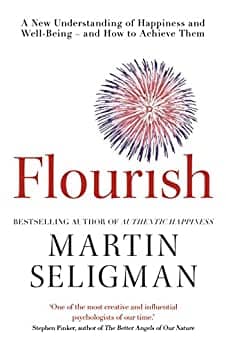This post may contain affiliate links. For more information please read my disclaimer.

I want to share with you two really interesting theories on happiness and what constitutes a happy life. Both are developed by Martin Seligman, often touted as the ‘father’ of positive psychology. I hope by learning about his research you can make changes in your own life to maximise your happiness and wellbeing.
In his first theory, outlined in his book Authentic Happiness, he proposes three kinds of happy lives.
The Pleasant Life
The pleasant life is one where you engage frequently and consistently in activities that bring about positive emotion and where you develop the skills to amplify them (such as savouring and mindfulness). It’s living a hedonistic lifestyle, having nice things and always chasing a fun time.
However, it doesn’t even have to be very extravagant. The pleasant life can be experienced through activities such as eating foods we love, playing games, or listening to great music. It’s attainable for the masses.
It’s safe to say that the pleasant life is one that most of us strive for, but, as Seligman explains, it has its drawbacks. Firstly, it seems that 50% of your positive experience is hereditary and while some mindsets and actions can be adopted to increase the experience of pleasure, it’s largely static. Secondly, the pleasant life habituates rapidly, meaning we quickly get used to it and have to keep chasing the next rush, and the next.
The Good Life
This is a life that dominated by flow. Flow is that feeling when we are intensely focussed on a task and enjoying it. It’s like time stops. While pleasure is an emotion, flow is a state.
It’s possible to activate flow more regularly by recrafting your life to leverage your highest strengths. It doesn’t make us happy and smiley but gets us more deeply absorbed in our work makes it more satisfying.
Don’t know what your strengths are? Luckily, there’s a free test for this. It doesn’t take too long and returns a list of your strengths (my top 5 were honesty, humour, prudence, kindness and perspective) as well as ideas on new ways to use them. I also found this test, created by Redbull in association with psychology professors from University College London and Columbia University New York. Although it takes a while to complete it’s more in-depth and the results are really interesting!
“The pleasant life might be had by drinking champagne and driving a Porsche, but not the good life. Rather, the good life is using your signature strengths every day to produce authentic happiness.”
Martin Seligman, PhD
The Meaningful Life
The final type of happy life is the meaningful life which is knowing and building your strengths to use them in service of something larger than yourself. These could be family, religion, community, country, or even ideas. It takes the focus off you and onto something else that you attach significance to.
Try each life for yourself
Each of these lives can be experienced and enhanced. Some ideas given by Martin Seligman are:
- Design a beautiful day and use savouring and mindfulness to enhance those pleasures. This is an easy one. Choose a Saturday and fill it with fun activities, making sure to appreciate each one.
- Have a gratitude visit. This one is scary but apparently incredibly effective. Write a thank you letter to someone you never properly thanked, visit the person, and read it to them. Seligman’s research shows that doing this results in lasting happiness as well as lower levels of depression even 6 months later.
- If you’re a couple, plan dates where each of you uses your highest strengths. These ‘strengths dates’ are shown to strengthen relationships.
- Do a fun vs philanthropy test. Try something fun and then do something altruistic towards someone else. You’ll find the fun activity causes a burst of pleasure but quickly fade. The altruistic action will create a lasting buzz.
Which life is the best?
While many of us will long for the pleasant life the reality is that the meaningful life is the greatest contributor towards life satisfaction, closely followed by the good life. The pursuit of pleasure has almost no lasting contribution to life satisfaction. It seems that if you have aspects of both the meaningful life and the good life then the pleasurable life is like a cherry on top. But without the other two, joys from the pleasant life are fleeting.
Watch Seligman discuss his model in his 2004 Ted Talk (he starts discussing it 9 minutes in)
But wait, there’s more
The 3 Orientations to Happiness was a good theory but Seligman developed it further in his 2011 book Flourish. In it, he explains that the above doesn’t go far enough to explain life satisfaction which can easily be influenced by mood. He builds on his previous theory by adding two more elements of wellbeing: Accomplishment and Positive Relationships.
Accomplishments: this involves the pursuit of success, achievement, and mastery both for its own sake and for the result. Many people might even pursue accomplishment when it is devoid of positive emotion and meaning. This can be observed in the world of politics or by professionals who work themselves to the ground with little or energy to enjoy the fruits of their labour.
Relationships: Seligman believes that our tendencies towards relationships are biologically ingrained and are especially powerful, as strong relationships can support the other components as well.
Together the five elements of his new theory form the acronym PERMA:
Pleasure
Engagement
Relationships
Meaning
Accomplishment
Conclusion: design your happiness
All the theory is great but what does it mean? Clearly, there are many facets to a happy life. Many of us concentrate too heavily on one or two components of the PERMA model or chase the pleasant life.
But we should identify our key strengths, pursue flow states, and work towards something greater than ourselves. Invest in relationships and strive for our goals to feel accomplished, but not sacrifice everything else in search of it. Effectively, create a balanced life.
I would recommend taking the Free VIA Institutes or the Redbull Wingfinder tests to find your highest strengths and use them in your life where possible. And although there was a lot of content in this article, spend some time auditing your life. Do you spend a healthy amount of energy on each component of the PERMA model? What’s lacking? What do you wish was different? It’s in your hands to change it!
Watch Martin Seligman discuss the PERMA model below
Check out Martin Seligman’s books here.





